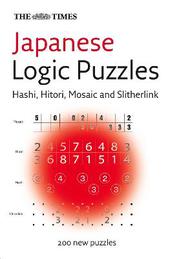
|
The Times Japanese Logic Puzzles: Hitori, hashi, slitherlink and mosaic (The Times Puzzle Books)
Paperback / softback
Main Details
| Title |
The Times Japanese Logic Puzzles: Hitori, hashi, slitherlink and mosaic (The Times Puzzle Books)
|
| Authors and Contributors |
Compiled by Puzzler Media
|
| Series | The Times Puzzle Books |
|---|
| Physical Properties |
| Format:Paperback / softback | | Pages:320 | | Dimensions(mm): Height 198,Width 129 |
|
| Category/Genre | Puzzles and quizzes |
|---|
| ISBN/Barcode |
9780007233267
|
| Classifications | Dewey:793.73 |
|---|
| Audience | |
|---|
|
Publishing Details |
| Publisher |
HarperCollins Publishers
|
| Imprint |
Times Books
|
| Publication Date |
20 March 2006 |
| Publication Country |
United Kingdom
|
Description
It appears we are a nation of puzzle obsessives after the phenomenal response to Su Doku. For those Su Doku fiends who are eager for variety, here is a collection of four of the most popular Japanese Logic Puzzles - Hitori, Hashi, Slitherlink, Mosaic. Guaranteed to strain your brain for hours. 200 new puzzles arranged according to difficulty. The four main puzzles are: Hitori -a 7x7 grid and the aim is to shade in the squares so that no number appears more than once in any row or column and no two adjacent squares, both horizontally and vertically, are both shaded. All the cells with numbers in will then form a single connected shape that is not divided up by shaded squares. All the single numbers you don't black out will be connected. Hashi consists of circles containing numbers. The circles act as islands. The object is to connect the islands with vertical and horizontal bridges. The number of bridges linked to an island must equal the number inside the island. There must also be a continuous path connecting all the islands. There can be up to two bridges between two islands. Bridges cannot cross islands or other bridges Slitherlink - a 10x10 grid composed of dots rather than lines. The aim is to connect adjacent dots with vertical or horizontal lines so that a single loop is formed with no crossings or branches. Each number indicates how many lines surround it, while empty cells may be surrounded by any number of lines. Mosaic - a 15x15 grid. This puzzle is based on looking at a square and those around it, rather than rows or columns of cells. Using simple logic alone, it is possible, from the numbers given, to fill in the grid and create a pixelated picture. In the grid, most cells have eight neighbours, making a block of nine cells: Cells along an edge have five neighbours and those in the corner only three. The number in a cell tells you how many of its adjacent cells and how many of its neighbours adjacent cells are to be filled in. The quantities are as follows -75 Hashi, 75 Slitherlink, 30 Hitori and 20 Mosaic. Includes hints and tips on how to solve them. As with Su Doku it is all about logic and reasoning, not mathematical genius.
Author Biography
The Puzzler
|